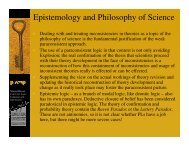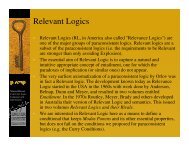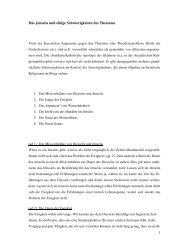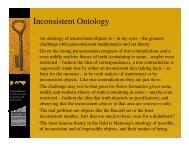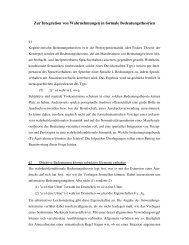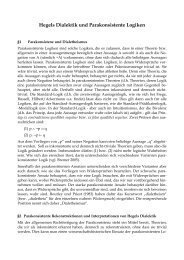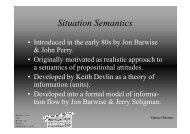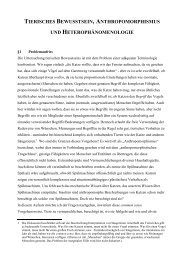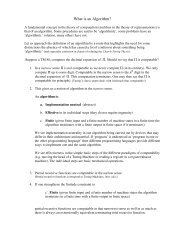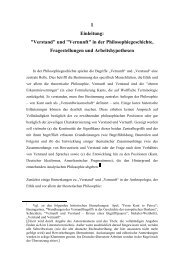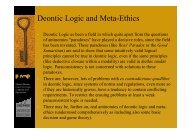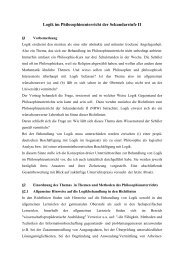lessons from sartre for the analytic philosophy of mind - Bremer
lessons from sartre for the analytic philosophy of mind - Bremer
lessons from sartre for the analytic philosophy of mind - Bremer
Create successful ePaper yourself
Turn your PDF publications into a flip-book with our unique Google optimized e-Paper software.
§1 Using Sartre<br />
LESSONS FROM SARTRE<br />
FOR THE ANALYTIC PHILOSOPHY OF MIND<br />
According to a well known account phenomenology and <strong>analytic</strong> <strong>philosophy</strong> have a common<br />
origin in <strong>the</strong> attempt to found and defend <strong>the</strong> objectivity <strong>of</strong> logic and <strong>philosophy</strong> against psy-<br />
chologism, a tradition <strong>of</strong> anti-pyschologism going back ultimately to Bernhard Bolzano. The<br />
respective founding fa<strong>the</strong>rs (Edmund Husserl and Gottlob Frege) differ in <strong>the</strong>ir methods and<br />
points <strong>of</strong> departure, so that – so <strong>the</strong> story is told (cf. Dummett 1988) – at last <strong>analytic</strong><br />
<strong>philosophy</strong> was more successful in that language as intersubjectively shared turned out to be<br />
<strong>the</strong> better foundation <strong>of</strong> objectivity than <strong>the</strong> realm <strong>of</strong> pure phenomenology, where<br />
phenomenologists disagree and cannot establish an intersubjectively valid method <strong>of</strong> eidetic<br />
reduction. Analytic <strong>philosophy</strong> <strong>of</strong> <strong>mind</strong> also shares with phenomenology <strong>the</strong> fundamental<br />
interest in intentionality. Accounting <strong>for</strong> intentionality – in terms <strong>of</strong> propositional attitudes –<br />
turned out not only to be successful, but became (in <strong>the</strong> guise <strong>of</strong> functionalism) <strong>the</strong> very<br />
paradigm <strong>of</strong> <strong>the</strong> <strong>philosophy</strong> <strong>of</strong> <strong>mind</strong> and <strong>the</strong> cognitive sciences. What is missing in that<br />
<strong>philosophy</strong> <strong>of</strong> <strong>mind</strong> – as its main proponents like Jerry Fodor readily admit (cf. Fodor 1995) –<br />
is an account <strong>of</strong> consciousness as experienced by someone. O<strong>the</strong>rs in <strong>the</strong> <strong>analytic</strong> camp have<br />
<strong>of</strong>fered <strong>the</strong>ories <strong>of</strong> consciousness focusing on phenomenality and so called qualia (cf.<br />
Chalmers 1996). What is mostly and strikingly missing in <strong>the</strong>se <strong>the</strong>ories are (sub-)<strong>the</strong>ories or<br />
models <strong>of</strong> <strong>the</strong> egological structures <strong>of</strong> consciousness (i.e. a <strong>the</strong>ory <strong>of</strong> <strong>the</strong> subjectively<br />
experienced or <strong>the</strong>oretically to be assumed agents/egos in consciousness). There are mostly<br />
reflections on <strong>the</strong> use <strong>of</strong> <strong>the</strong> personal pronoun “I” and a undifferentiated notion <strong>of</strong> a/<strong>the</strong> “self”.<br />
It is here, I think, that <strong>the</strong> <strong>analytic</strong> <strong>philosophy</strong> <strong>of</strong> <strong>mind</strong> should revisit phenomenology again.
The egological structures <strong>of</strong> consciousness have been a – or even <strong>the</strong> main – topic <strong>of</strong> Kantian,<br />
Idealistic and phenomenological <strong>the</strong>ories <strong>of</strong> consciousness.<br />
I have chosen Jean-Paul Sartre as my point <strong>of</strong> departure, since I believe that he has an ad-<br />
vanced <strong>the</strong>ory <strong>of</strong> <strong>the</strong>se structures, and that some <strong>of</strong> his insights are congenial to <strong>the</strong>ses in <strong>the</strong><br />
<strong>analytic</strong> <strong>philosophy</strong> <strong>of</strong> <strong>mind</strong>. Sartre develops this <strong>the</strong>ory in The Transcedence <strong>of</strong> <strong>the</strong> Ego<br />
(Sartre 1937), <strong>the</strong> introduction to Being and Nothingness (Sartre 1943) and his talk “Self-<br />
Awareness and Self-Knowledge” (Sartre 1948).<br />
There are positive and negative <strong>lessons</strong> <strong>from</strong> Sartre:<br />
• Taking up some <strong>of</strong> his ideas one may arrive at a better model <strong>of</strong> consciousness in <strong>the</strong><br />
<strong>analytic</strong> <strong>philosophy</strong> <strong>of</strong> <strong>mind</strong>; representing some <strong>of</strong> his ideas within <strong>the</strong> language and<br />
<strong>the</strong> models <strong>of</strong> a functionalist <strong>the</strong>ory <strong>of</strong> <strong>mind</strong> makes <strong>the</strong>m more accessible and inte-<br />
grates <strong>the</strong>m into <strong>the</strong> wider picture.<br />
• Sartre, like any philosopher, errs at some points, I believe; but <strong>the</strong>se errors may be<br />
instructive, especially in as much as <strong>the</strong>y mirror some errors in some current <strong>the</strong>ories<br />
<strong>of</strong> consciousness.<br />
This paper, <strong>the</strong>re<strong>for</strong>e, is not a piece <strong>of</strong> Sartre scholarship, but an attempt <strong>of</strong> a “friendly take-<br />
over” <strong>of</strong> some ideas I ascribe to Sartre into current models in <strong>the</strong> <strong>philosophy</strong> <strong>of</strong> <strong>mind</strong>.<br />
§2 Ordinary Language and <strong>the</strong> Self<br />
Talking <strong>of</strong> <strong>the</strong> self or an ego is <strong>of</strong>ten ridiculed by <strong>analytic</strong> philosophers by pointing out that<br />
sentences like<br />
(1*) I came around and I brought (with me) my Self.<br />
(2*) She visited Frank and my I was <strong>the</strong>re, too.<br />
are ungrammatical. They are ungrammatical, if <strong>the</strong>y are, in <strong>the</strong> sense <strong>of</strong> running against <strong>the</strong><br />
meaning <strong>of</strong> <strong>the</strong> expression involved, i.e. <strong>the</strong>ir common usage. This is, however, a very weak<br />
argument. The strangeness <strong>of</strong> (1*) might be accounted <strong>for</strong> by a proponent <strong>of</strong> a Self in noting<br />
2
<strong>the</strong> inseparability <strong>of</strong> person and self, so that it is no more strange than<br />
(3?) I came around and I brought (with me) my body.<br />
This may not work <strong>for</strong> all constructions, (2*) may be an example <strong>of</strong> real deviance. Such devi-<br />
ance, never<strong>the</strong>less, does not show much. Starting <strong>from</strong> ordinary usage sentences like<br />
(4) Near heavy bodies space is curved.<br />
(5) All full explanation has to consider <strong>the</strong> colour <strong>of</strong> <strong>the</strong> quarks.<br />
are nonsensical as well, since <strong>the</strong>re is nothing, according to our pre-scientific understanding <strong>of</strong><br />
space and be<strong>for</strong>e redefining <strong>the</strong> notion, against which it can be curved; and subatomic par-<br />
ticles simply have no colours. Once it is conceded that scientific language may deviate <strong>from</strong><br />
ordinary and pre-scientific usage <strong>the</strong>re is no exception <strong>for</strong> <strong>the</strong> <strong>philosophy</strong> <strong>of</strong> <strong>mind</strong>. Maybe<br />
“<strong>the</strong> I”, different sorts <strong>of</strong> “Egos” and “<strong>the</strong> Self” are <strong>the</strong>oretical posits. Given a background<br />
<strong>the</strong>ory, sentences like<br />
(6) The I unites experiences to present <strong>the</strong> Self to us.<br />
may not sound strange any longer.<br />
The deviance <strong>from</strong> ordinary usage may be considered a special problem <strong>for</strong> <strong>philosophy</strong> in as<br />
much as it is assumed to merely work with our intuitive understanding <strong>of</strong> ourselves and <strong>the</strong><br />
world. Although this is partially right, this poses no real problem. On <strong>the</strong> one hand this com-<br />
plaint cannot be brought <strong>for</strong>ward by <strong>analytic</strong> philosophers, who – especially in <strong>the</strong> cognitive<br />
sciences – stress <strong>the</strong> continuity <strong>of</strong> scientific and philosophical methods. On <strong>the</strong> o<strong>the</strong>r hand <strong>the</strong><br />
problem may be due to <strong>the</strong> intricate character <strong>of</strong> <strong>the</strong> distinctions involved. There are plenty <strong>of</strong><br />
o<strong>the</strong>r concepts and distinctions introduced by philosophers to re-construct our ordinary under-<br />
standing <strong>of</strong> ourselves and our access to reality (e.g. <strong>the</strong> terminology <strong>of</strong> “possible world” se-<br />
mantics, <strong>the</strong> vocabulary <strong>of</strong> epistemic appraisal and confirmation, like “falsifiable”, “sim-<br />
plicity”, keeping “indirect” and “direct” duties apart – and so on).<br />
§3 Self Denial in <strong>the</strong> Analytic Philosophy <strong>of</strong> Mind and in Sartre<br />
3
Ano<strong>the</strong>r criticism has focused on “<strong>the</strong>” Self as a supposed object we encounter in self-aware-<br />
ness. The deeper – even if philosophically somewhat shallow – reason that self-awareness is<br />
neglected as a topic by many <strong>analytic</strong> philosophers may just be that it is understood as being<br />
<strong>the</strong> awareness <strong>of</strong> a self as an object. If we exclude <strong>the</strong> possiblity that self-awareness might be<br />
more, given <strong>the</strong> dubious character <strong>of</strong> “<strong>the</strong> Self” as an object, self-awareness drops out <strong>of</strong><br />
consideration as being a mere by-product (a secondary construction) <strong>of</strong> more interesting and<br />
fundamental mental events.<br />
Never<strong>the</strong>less <strong>the</strong>re is something to this criticism. Marvin Minsky (1985) sees <strong>the</strong> self as a<br />
construct: Thoughts are outputs <strong>of</strong> <strong>the</strong> cognitive systems, where several agencies, each <strong>of</strong><br />
which doing only its job, work in <strong>the</strong> background being involved in perception, association,<br />
memory access and where several in<strong>for</strong>mation states compete <strong>for</strong> <strong>the</strong> access to consciousness;<br />
some <strong>of</strong> <strong>the</strong> in<strong>for</strong>mation states model control states that work on lower states; <strong>from</strong> <strong>the</strong>se<br />
states a self-image <strong>of</strong> <strong>the</strong> system is built up; this construct is <strong>the</strong> self, seen as <strong>the</strong> agent who<br />
has <strong>the</strong> thoughts in question and who is responsible <strong>for</strong> <strong>the</strong> actions <strong>of</strong> <strong>the</strong> system; <strong>the</strong> self is<br />
not some additional agent inside you looking at <strong>the</strong> per<strong>for</strong>mance <strong>of</strong> <strong>the</strong> o<strong>the</strong>r agencies; <strong>the</strong><br />
self is a representation; <strong>the</strong> self is ascribed properties that are essential to give <strong>the</strong> system’s<br />
self-representation unity; so <strong>the</strong> self develops as a narrative in which language is used to de-<br />
scribe an entity with coherent properties. Similar accounts <strong>of</strong> <strong>the</strong> self as (narrative)<br />
construction one can find in (Dennett 1991) and (Metzinger 1995).<br />
Interestingly this opinion is not far <strong>of</strong> <strong>from</strong> Sartre’s. The me is, <strong>for</strong> Sartre, a posited transcen-<br />
dent object (cf. Sartre 1937: 70, 76). The self – called “ego” by Sartre here – is something<br />
brought be<strong>for</strong>e consciousness, is an object and not that which is intentionally directed at this<br />
object. The self is “an object”, not something active. The self is posited as <strong>the</strong> origin <strong>of</strong> acts<br />
and as <strong>the</strong>ir principle <strong>of</strong> unification:<br />
[C]onsciousness projects its own spontaneity into <strong>the</strong> ego-object in order to confer on <strong>the</strong><br />
ego <strong>the</strong> creative power which is absolutely necessary to it. But this spontaneity, represented<br />
4
and hypostatized in an object, becomes a degraded and bastard spontaneity, […].<br />
(Sartre 1937: 81)<br />
So we may understand <strong>the</strong> Self as representing <strong>the</strong> whole “society <strong>of</strong> <strong>mind</strong>” (with all its<br />
processes and agencies) as a single agent. With <strong>the</strong> concept <strong>of</strong> “<strong>the</strong> Self” we represent <strong>the</strong><br />
whole system/architecture. This is not wrong in as much as that system is us, and is acting. It<br />
is misleading in as much as we might start a search <strong>for</strong> that agent Self that is not among <strong>the</strong><br />
agents <strong>of</strong> <strong>the</strong> <strong>mind</strong>. The Self is never<strong>the</strong>less phenomenally real and can be described in its<br />
features. The self represents <strong>the</strong> unification process within <strong>the</strong> cognitive system, including <strong>the</strong><br />
occurrence <strong>of</strong> deliberate (verbal) control states. O<strong>the</strong>r features <strong>of</strong> <strong>the</strong> Self may correspond to<br />
hidden cognitive agents, and so again <strong>the</strong> Self as construct is not inadequate. It is, <strong>the</strong>re<strong>for</strong>e,<br />
misleading to say that by positing <strong>the</strong> Self we are victims <strong>of</strong> an illusion. Sartre may come<br />
close to this (see also Priest 2000: 124-26), Metzinger (1995) really claims this; but <strong>the</strong> mere<br />
fact that <strong>the</strong> Self is a representation does not make it a misrepresentation. If <strong>the</strong> Self is a<br />
representation <strong>of</strong> <strong>the</strong> whole cognitive system its referent really does what it is described as<br />
doing. Even our narrative <strong>of</strong> <strong>the</strong> Self re-enters memory and so influences our fur<strong>the</strong>r acts. For<br />
<strong>the</strong> phenomenology and structural modelling <strong>of</strong> self-awareness it is indeed important to see<br />
that <strong>the</strong> Self as representation is not <strong>the</strong> agent <strong>of</strong> <strong>the</strong> act. Here a hypostatization would block<br />
<strong>the</strong> view on <strong>the</strong> pre-reflexive structures <strong>of</strong> consciousness and <strong>the</strong> Ego. The decisive point is to<br />
see <strong>the</strong> Self not as <strong>the</strong> agent in control but as a (narrative) construct.<br />
Having thus downsized <strong>the</strong> Self one has to avoid overdoing <strong>the</strong> deconstruction. Overdoing <strong>the</strong><br />
rejection <strong>of</strong> supposed entities in <strong>the</strong> vicinity <strong>of</strong> self-awareness loses <strong>the</strong> phenomenon itself.<br />
The crucial distinction that is <strong>of</strong>ten overlooked, and which is at <strong>the</strong> centre <strong>of</strong> my paper, is that<br />
between <strong>the</strong> Self and – at least one – I, which both have to be kept apart <strong>from</strong> <strong>the</strong> person that I<br />
am. Sartre clearly sees that <strong>the</strong>re is a question <strong>of</strong> <strong>the</strong> Ego to be considered after having set<br />
aside <strong>the</strong> Me. The phenomena put several questions to us ei<strong>the</strong>r as phenomenologists or<br />
cognitive scientists by <strong>the</strong> phenomena.<br />
5
§4 A Short Phenomenology <strong>of</strong> Some Distinctions<br />
Here are a couple <strong>of</strong> basic observations concerning my knowledge and experience <strong>of</strong> myself:<br />
Phenomenon I<br />
“I” is a singular term. Singular terms are used in statements to refer to objects which are said<br />
to have some property, which is referred to by <strong>the</strong> predicate (<strong>the</strong> general term):<br />
(1) The table in lecture hall 3F is white<br />
Statement (1) is true if one has identified by <strong>the</strong> description (or its meaning) an object and<br />
discerns (by <strong>the</strong> meaning <strong>of</strong> “( ) is white”) that it has <strong>the</strong> corresponding property. Singular<br />
terms serve to identify objects. Identification need not be successful. “The headless<br />
horseman” is a singular term, but refers to nothing.<br />
The meaning <strong>of</strong> “I” is usually given as “<strong>the</strong> one speaking”. That seems reasonable: If some-<br />
body uses <strong>the</strong> term “I” we (<strong>the</strong> hearers) know that she is talking <strong>of</strong> herself. Can “I”, however,<br />
be employed to characterize self-awareness? – It seems not. Self-awareness cannot have <strong>the</strong><br />
structure <strong>of</strong> <strong>the</strong> following statement:<br />
(2) I see a white table in lecture hall 3F.<br />
The question <strong>of</strong> identifying <strong>the</strong> referent (i.e. <strong>the</strong> question generally associated with singular<br />
terms) does not arise: I need not identify myself <strong>for</strong> myself. I am immediately present to my-<br />
self.<br />
Fur<strong>the</strong>rmore <strong>the</strong>re is no chance <strong>of</strong> misidentification here. I am present in my consciousness<br />
and <strong>the</strong>re is no one else whom I could mistake <strong>for</strong> <strong>the</strong> referent <strong>of</strong> “I” or whom I could mistake<br />
<strong>for</strong> myself. Fur<strong>the</strong>rmore I have to know myself as <strong>the</strong> one who does <strong>the</strong> identification in every<br />
act <strong>of</strong> identifying – even if I am not doing this in inner speech (i.e. I am not using <strong>the</strong> pronoun<br />
“I) I have to be aware <strong>of</strong> <strong>the</strong> act <strong>of</strong> identifying. And to identify myself I have to know myself<br />
already!<br />
6
These phenomena throw a bad light on a propositionalist <strong>the</strong>ory (employing <strong>the</strong> pronoun “I”<br />
to account <strong>for</strong> <strong>the</strong> structure <strong>of</strong> self-awareness).<br />
Phenomenon II<br />
I am a person. I can refer to that person <strong>for</strong> example by <strong>the</strong> description “<strong>the</strong> one who is lec-<br />
turing on December, 18 th , in lecture hall 3F at 4 p.m.”. The description refers to me and I<br />
know that. I can describe myself in several ways, but not all ways <strong>of</strong> referring to myself as a<br />
person are dependent on a description. Some famous anecdotes highlighting my peculiar<br />
knowledge <strong>of</strong> myself make this clear: Jon Perry follows with his trolley a sugar line in <strong>the</strong><br />
supermarket to draw <strong>the</strong> responsible customer’s attention to his defective sugar bag. After a<br />
while he recognizes that he himself has laid <strong>the</strong> sugar line with a defective sugar bag in his<br />
trolley (cf. Perry 1979). – How can one describe this case?<br />
Jon Perry had at some time t (when he started his search) an opinion with respect to <strong>the</strong> cus-<br />
tomer looked <strong>for</strong>. At this time t Perry is de facto, although he does not know it, this very cus-<br />
tomer. Perry has at this time de facto a belief about himself, only he does not recognize this.<br />
At a later time t* Perry recognizes that he himself is <strong>the</strong> customer looked <strong>for</strong>. Now he still has<br />
de facto a belief about <strong>the</strong> customer, but additionally he now has a belief de se with respect to<br />
himself (in an emphatic sense <strong>of</strong> “himself” which points to <strong>the</strong> self-access to be explained<br />
here).<br />
This phenomenon shows that <strong>the</strong>re is a difference between beliefs/attitudes in which I am<br />
referred to by a description and such in which I know about myself.<br />
Phenomenon III<br />
“The I/<strong>the</strong> Ego” sounds peculiar, echoing philosophical traditions out <strong>of</strong> fashion. With <strong>the</strong><br />
first phenomenon, however, we have already seen that to know about some objects involves<br />
knowing in some way about myself as <strong>the</strong> one who knows <strong>the</strong> objects. There is obviously in<br />
any conscious mental event – if we stick to individual mental acts <strong>for</strong> <strong>the</strong> moment – some-<br />
thing that attributes that very act to itself as <strong>the</strong> thinking “thing”. And this I is not a modifica-<br />
7
tion that sometimes occurs, as <strong>the</strong> anecdotes in <strong>the</strong> second phenomenon may make you<br />
believe, but is present in every conscious episode. (The anecdote is telling by being an<br />
instance <strong>of</strong> misdescribing myself using a description although I am immediately given to<br />
myself without using a description.) Even if I am not engaged in inner speech (processing<br />
thoughts in public language), but looking absent <strong>mind</strong>edly out <strong>of</strong> <strong>the</strong> window – never<strong>the</strong>less I<br />
know that it is me who is looking out. I do not have to use <strong>the</strong> pronoun „I“ <strong>for</strong> this, I am just<br />
having my thoughts. There is no question as to who is having <strong>the</strong>se thoughts. I am<br />
immediately given to myself (I am “at“/”by” myself). There are mental events (e.g. in<br />
phonetic decoding) which are not conscious, but if some act is conscious I am present. In this<br />
sense human consciousness is self-awareness (knowing oneself as thinking) – whatever <strong>for</strong>ms<br />
<strong>of</strong> consciousness <strong>the</strong>re might be in <strong>the</strong> animal kingdom. It is not <strong>the</strong> case that we first have<br />
consciousness and <strong>the</strong>n – in some additional act? – <strong>the</strong>re comes self-awareness. Whatever I<br />
know <strong>of</strong> consciously I know as known by me. Whatever content I am thinking I know about<br />
me. Mental content is content <strong>for</strong> somebody. This somebody (<strong>the</strong> I) is (phenomenologically)<br />
<strong>the</strong> same whereas <strong>the</strong> content changes. Although <strong>the</strong> content or <strong>the</strong> scene be<strong>for</strong>e my eyes<br />
changes I am still <strong>the</strong>re. We experience a continuous agent <strong>of</strong> thinking while <strong>the</strong> content<br />
varies. The I does not fall on <strong>the</strong> side <strong>of</strong> mental content (in <strong>the</strong> sense <strong>of</strong> <strong>the</strong> observed scene,<br />
<strong>the</strong> sentence thought etc.). The I might be <strong>the</strong> agent I experience within my mental acts as <strong>the</strong><br />
one who does <strong>the</strong> thinking (<strong>the</strong> supposed actor <strong>of</strong> <strong>the</strong> acts <strong>of</strong> thinking). Is it not <strong>the</strong> case that I<br />
am thinking – and not that thinking happens to me?<br />
Phenomenon IV<br />
There is, however, a fur<strong>the</strong>r distinction to be made with respect to <strong>the</strong> just mentioned role <strong>of</strong><br />
<strong>the</strong> Ego. Sometimes, although <strong>the</strong> question does not arise whose acts are <strong>the</strong>se, I am absorbed<br />
in whatever I am doing. I am absorbed in looking at <strong>the</strong> cat playing with <strong>the</strong> cork, or I am<br />
engrossed in what I am reading. Then – without any ef<strong>for</strong>t – immediately I can become aware<br />
that I am looking at <strong>the</strong> cat, that I am reading. Now I am explicit about <strong>the</strong> subject <strong>of</strong> <strong>the</strong> act,<br />
8
no longer is it only <strong>the</strong> content I was absorbed in that is presented. Sartre himself (1937: 46-<br />
49) uses <strong>the</strong> example <strong>of</strong> reading or looking at a picture. (Sartre 1948: 42-45) expresses <strong>the</strong><br />
phenomenon as being at <strong>the</strong> same time at myself (because <strong>of</strong> <strong>the</strong> pre-reflexive cogito) and<br />
detached <strong>from</strong> myself (since it is only a pre-reflexive cogito, reflecting breaking <strong>the</strong><br />
immediacy to <strong>the</strong> object). This shift is almost imperceptible. It is not that I consciously intend<br />
now to focus on myself or set out to see who is doing <strong>the</strong> thinking. It just happens that <strong>from</strong><br />
one moment to <strong>the</strong> next I realize my Ego as being <strong>the</strong> subject <strong>of</strong> my acts. If <strong>the</strong>re is some<br />
reflection involved here, it does not take place as explicit reflecting by some <strong>of</strong> my acts on<br />
ano<strong>the</strong>r <strong>of</strong> my acts. If this shift towards <strong>the</strong> I is a reflection, it has to be modelled in some<br />
o<strong>the</strong>r fashion.<br />
Phenomenon V<br />
We have to add a phenomenological remark on (some) representations: Suppose you hear a<br />
bear humming. By <strong>the</strong> humming we refer to <strong>the</strong> bear as its source. We represent <strong>the</strong> bear as<br />
humming. The humming sound represents <strong>the</strong> bear in some fashion (including pitch, fre-<br />
quency etc.). The humming itself, however, by pain <strong>of</strong> a vicious regress, is not represented<br />
“as” itself. To hear <strong>the</strong> humming is nothing besides or above <strong>the</strong> fact <strong>of</strong> having some repre-<br />
sentation. Expressed as a general observation:<br />
(F) There are representations with respect to which it is <strong>the</strong> case that <strong>the</strong>ir being<br />
tokened is accompanied by a phenomenal quality.<br />
By tokening such a representation some quality is given in consciousness.<br />
Several distinctions have to be made in <strong>the</strong> light <strong>of</strong> <strong>the</strong>se phenomena:<br />
1. “<strong>the</strong> Self“ is that vague complex <strong>of</strong> biography and biographical knowledge, discussed<br />
in §3, that toge<strong>the</strong>r with some body defines an individual person; names and descrip-<br />
tions refer to that person as known by me and o<strong>the</strong>rs; <strong>the</strong> Self falls on <strong>the</strong> side <strong>of</strong> con-<br />
tent <strong>of</strong> conscious states.<br />
9
2. “<strong>the</strong> I/<strong>the</strong> Ego“ is my I that, although in fact related to an individual Self, contains <strong>the</strong><br />
structural functions which are shared by conscious beings (e.g. in <strong>the</strong> acts <strong>of</strong> percep-<br />
tion mentioned above); let us call it <strong>the</strong> Ego or <strong>the</strong> functional I; in <strong>the</strong> light <strong>of</strong> phe-<br />
nomenon IV we will have to distinguish two components here, depending on whe<strong>the</strong>r<br />
(2a) <strong>the</strong> focus is on <strong>the</strong> I itself, which need not include biographical knowledge and so<br />
is not <strong>the</strong> same as (1), or (2b) on <strong>the</strong> objects that I am aware <strong>of</strong>.<br />
3. “<strong>the</strong> implicit I” is <strong>the</strong> functional correlate <strong>of</strong> <strong>the</strong> functional I within <strong>the</strong> realm <strong>of</strong> tacit<br />
knowledge or mental events that are not conscious, but never<strong>the</strong>less are processed<br />
(e.g. in memory or pre-conscious association) as being self-attributed states.<br />
4. <strong>the</strong> set <strong>of</strong> conditions necessary <strong>for</strong> consciousness to be possible at all, to arise in <strong>the</strong><br />
first place are not present in consciousness itself; in correlation to <strong>the</strong> talk <strong>of</strong> <strong>the</strong> Ego<br />
as present in consciousness one might talk <strong>of</strong> a “transcendental Ego” here, but this<br />
analogy to an agent as we know it <strong>from</strong> consciousness may be simply mistaken. 1<br />
A <strong>the</strong>ory <strong>of</strong> <strong>the</strong> logical structure <strong>of</strong> my knowledge <strong>of</strong> myself (including <strong>the</strong> de se-<strong>the</strong>ory <strong>of</strong><br />
self-awareness introduced in <strong>the</strong> next but one paragraph) deals mainly with <strong>the</strong> functional I,<br />
i.e. phenomenon (2), and secondarily with its relations to <strong>the</strong> o<strong>the</strong>r instances. It does not deal<br />
primarily with biographies or <strong>the</strong> Self. The talk <strong>of</strong> a transcendental unity <strong>of</strong> consciousness has<br />
been trans<strong>for</strong>med within cognitive science into <strong>the</strong> talk about <strong>the</strong> architecture <strong>of</strong> a cognitive<br />
system that may give rise to consciousness. Keep also in <strong>mind</strong> <strong>the</strong> fact (F) about<br />
representations.<br />
Sartre’s <strong>the</strong>ory also distinguishes between <strong>the</strong> Self/Me as a biographical construct and <strong>the</strong><br />
functions <strong>of</strong> self-awareness. His distinction between a pre-reflexive and a reflexive cogito<br />
may mirror <strong>the</strong> distinction between (2b) and (2a).<br />
§5 Sartre’s Conception <strong>of</strong> <strong>the</strong> Pre-Reflexive Cogito<br />
10
Sartre in his way defends <strong>the</strong> <strong>the</strong>sis that consciousness cannot be separated <strong>from</strong> self-con-<br />
sciousness, as was alluded to phenomenologically in <strong>the</strong> preceding paragraph. It is in this<br />
context that his introduction <strong>of</strong> a pre-reflexive cogito is crucial. It is a necessary condition <strong>for</strong><br />
being conscious <strong>of</strong> some object to be conscious <strong>of</strong> being conscious, since an unnoticed con-<br />
sciousness is an absurdity (cf. Sartre 1943: 18). Consciousness presents itself (to itself). This<br />
cannot be ano<strong>the</strong>r intentional act on pains <strong>of</strong> a regress <strong>of</strong> presupposed or required acts <strong>of</strong> con-<br />
sciousness. Thus <strong>the</strong> accompanying consciousness <strong>of</strong> oneself is no additional act besides <strong>the</strong><br />
intentional act, and it is not a reflexive act having <strong>the</strong> intentional act as object:<br />
[T]his consciousness <strong>of</strong> consciousness … is not positional, which is to say that conscious-<br />
ness is not <strong>for</strong> itself its own object. Its object is by nature outside <strong>of</strong> it, and that is why con-<br />
sciousness posits and grasps <strong>the</strong> object in <strong>the</strong> same act. (Sartre 1937: 40-41)<br />
This pre-reflexive cogito is within one and <strong>the</strong> same act that is a conscious act presenting<br />
some intentional object, it is not within a reflective act having <strong>the</strong> intentional act itself as an<br />
object. Nei<strong>the</strong>r does it come after <strong>the</strong>re being some intentional act already, nor is it vacuously<br />
present to be filled <strong>the</strong>n with content. There is only <strong>the</strong> one (unified) conscious state<br />
representing an object in which I am also (non-positionally) aware <strong>of</strong> myself (cf. Sartre 1943:<br />
21). My being conscious <strong>of</strong> myself does not fall not on <strong>the</strong> side <strong>of</strong> <strong>the</strong> content <strong>of</strong> my conscious<br />
acts. It is responsible both <strong>for</strong> <strong>the</strong> content being conscious <strong>for</strong> me, although I do not focus on<br />
me, and is <strong>the</strong> precondition <strong>for</strong> <strong>the</strong> reflexive cogito. In having, <strong>the</strong>n, a reflexive cogito, I once<br />
again have a pre-reflexive cogito in order <strong>for</strong> <strong>the</strong> act <strong>of</strong> reflection to be a conscious act.<br />
Note <strong>for</strong> <strong>the</strong> following paragraph that that I which we call pre-reflexive cogito is not an object<br />
<strong>of</strong> thought as long as it is active in accompanying o<strong>the</strong>r contents. It is related to but not phe-<br />
nomenally identical to <strong>the</strong> I brought into focus by reflection. The latter, in addition, has to be<br />
kept apart <strong>from</strong> <strong>the</strong> Self. The pre-reflexive cogito does not have itself as an object, so we may<br />
model it along <strong>the</strong> line <strong>of</strong> fact (F) as some peculiar representation that with its mere occur-<br />
rence has its crucial features. Since <strong>the</strong> pre-reflexive cogito is no act, it cannot be phenome-<br />
11
nologically brought into focus itself, although <strong>the</strong> immediacy <strong>of</strong> any conscious act may be<br />
claimed as evidence <strong>for</strong> it. Its characteristic is only given negatively, in terms <strong>of</strong> what it isn’t.<br />
For a <strong>the</strong>ory <strong>of</strong> self-awareness we need a working model. Here we turn to some help <strong>from</strong><br />
<strong>the</strong>ories developed within <strong>analytic</strong> <strong>philosophy</strong> <strong>of</strong> <strong>mind</strong>.<br />
§6 de se Theories <strong>of</strong> Self-Awareness<br />
Within <strong>the</strong> <strong>philosophy</strong> <strong>of</strong> <strong>mind</strong> we can distinguish between phenomenological and<br />
psychological <strong>the</strong>ories. A psychological account, say functionalism, refers to <strong>the</strong> role <strong>the</strong> state<br />
has with respect to o<strong>the</strong>r states or <strong>the</strong> system’s behaviour. Within such an explanation it might<br />
be important that it “is like something” to be in that state, but not all psychological accounts<br />
<strong>of</strong> some states require that is feels like something to be in such a state. A psychological <strong>the</strong>ory<br />
need not account <strong>for</strong> (all) phenomenological features <strong>of</strong> mental states. There<strong>for</strong>e one and <strong>the</strong><br />
same psychological <strong>the</strong>ory is compatible with different phenomenological descriptions. A<br />
complete functionalist <strong>the</strong>ory <strong>of</strong> self-awareness comprises:<br />
1. <strong>the</strong> identification <strong>of</strong> self-awareness by giving criteria <strong>for</strong> is being ascribed and by<br />
explaining it’s causal role.<br />
2. <strong>the</strong> specification <strong>of</strong> <strong>the</strong> <strong>for</strong>mat <strong>of</strong> representation <strong>of</strong> mental content, which explains<br />
it’s inferential structure and it’s causal efficacy.<br />
One and <strong>the</strong> same answer to (1) can be coupled with different answers to (2). The non-pro-<br />
positionalist account <strong>of</strong> self-awareness discussed here (a de se-<strong>the</strong>ory) is an answer to (2). The<br />
de se-<strong>the</strong>ory, <strong>the</strong>re<strong>for</strong>e, is at least in part a phenomenological <strong>the</strong>ory. The basic alternative is a<br />
propositionalist account in which all states <strong>of</strong> self-awareness (including <strong>the</strong> states/aspects<br />
enabling self-awareness) have to be propositional if not also sentential.<br />
De se-<strong>the</strong>ories (in short: DST) were developed by Roderick Chisholm (1981) and David<br />
Lewis (1979). I will not explain <strong>the</strong>ir <strong>the</strong>ories, but take a few <strong>of</strong> Chisholm’s considerations as<br />
12
a starting point <strong>for</strong> some systematic explorations. Both <strong>the</strong>ories are embedded in peculiar on-<br />
tologies that need not concern us here.<br />
Roderick Chisholm puts <strong>the</strong> basic <strong>the</strong>sis <strong>of</strong> a de se-<strong>the</strong>ory as follows (cf. 1981: 1):<br />
(A1) There are attitudes which are not propositional<br />
but self-attributions <strong>of</strong> properties.<br />
The objects <strong>of</strong> <strong>the</strong>se attitudes do not belong to <strong>the</strong>ir content, as §4 said, so that <strong>the</strong> content<br />
consists just <strong>of</strong> <strong>the</strong> properties <strong>the</strong> supposed object is considered to have:<br />
(A1') (i) Some contents <strong>of</strong> attitudes are properties.<br />
Instead <strong>of</strong> propositional attitudes DST speak <strong>of</strong> attitudes in a more general way. Propositional<br />
attitudes are secondary with respect to <strong>the</strong> basic non-propositional self-attributions. (A1) is <strong>the</strong><br />
fundamental structural axiom <strong>of</strong> DST. It uses <strong>the</strong> two relata: properties and I (see (A1’)(ii)<br />
below). The fundamental relation is <strong>the</strong> relation <strong>of</strong> self-attribution which involves direct self-<br />
reference. (A1’) contradicts <strong>the</strong> <strong>the</strong>sis <strong>of</strong> <strong>the</strong> propositionalist who claims that <strong>the</strong> content <strong>of</strong> an<br />
attitude can be given only by a proposition or a sentence. In a proposition or sentence<br />
properties are ascribed, but <strong>the</strong> referent (or its description) is part <strong>of</strong> <strong>the</strong> content. According to<br />
(A1) <strong>the</strong> object <strong>of</strong> some attitudes is descriptionless and, <strong>the</strong>re<strong>for</strong>e, contentless. This object is,<br />
according to Chisholm, <strong>the</strong> I:<br />
(A1') (ii) The I does not belong in/to <strong>the</strong> content <strong>of</strong> some attitudes.<br />
To be justified is <strong>the</strong> following <strong>the</strong>sis:<br />
(T1) The primary <strong>for</strong>m <strong>of</strong> reference is direct self-reference.<br />
This <strong>the</strong>sis should be justified by defining <strong>the</strong> ordinary ways <strong>of</strong> referring (usage <strong>of</strong> statements,<br />
singular terms, beliefs, perceptions…) with <strong>the</strong> use <strong>of</strong> <strong>the</strong> concept <strong>of</strong> direct self-reference.<br />
It has to be shown, thus, that <strong>the</strong> following generalizations are true:<br />
(T2) The primary <strong>for</strong>m <strong>of</strong> belief is <strong>the</strong> self-attribution <strong>of</strong> properties.<br />
(T3) The I is <strong>the</strong> primary object <strong>of</strong> my attitudes.<br />
13
These basic ideas are taken up here. Of course it has to be made clear which I is <strong>the</strong> one that is<br />
a relate in conscious acts, considering Sartre’s distinction between a pre-reflexive and a<br />
reflexive cogito. Sartre and <strong>the</strong> DST seem to agree that <strong>the</strong> subject <strong>of</strong> consciousness does not<br />
belong to <strong>the</strong> side <strong>of</strong> <strong>the</strong> content. Whe<strong>the</strong>r <strong>the</strong> reflexive cogito has to be taken as<br />
propositional, as one may take it in Sartre, is not that clear. The pre-reflexive cogito certainly<br />
cannot be, on pains <strong>of</strong> <strong>the</strong> well known regresses – here Sartre and <strong>the</strong> DST agree. Fur<strong>the</strong>rmore<br />
<strong>the</strong> talk <strong>of</strong> “object” in <strong>the</strong> DST, say in (T3) should ei<strong>the</strong>r not be taken in <strong>the</strong> sense in which<br />
Sartre denies that <strong>the</strong> pre-reflexive cogito is <strong>the</strong> object <strong>of</strong> a conscious act, in which case (T3)<br />
would be false <strong>for</strong> it, or <strong>the</strong> talk <strong>of</strong> “object” should be taken as in Sartre and <strong>the</strong>n <strong>the</strong>re will be<br />
a distinction between <strong>the</strong> reflexive I, <strong>for</strong> which something like (T3) holds, and <strong>the</strong> pre-<br />
reflexive cogito.<br />
§7 A Syn<strong>the</strong>sis <strong>of</strong> <strong>the</strong> Pre-reflexive Cogito with a de se Theory <strong>of</strong> Self-Awareness<br />
De se <strong>the</strong>ories and Sartre’s conception share <strong>the</strong> crucial axiom that <strong>the</strong> I responsible <strong>for</strong> being<br />
also aware <strong>of</strong> myself in being aware <strong>of</strong> something else is not part <strong>of</strong> <strong>the</strong> content <strong>of</strong> my thought<br />
proper. Self-awareness – and thus any consciousness, since <strong>the</strong> two phenomena cannot be<br />
brought apart – has two components: my knowledge <strong>of</strong> myself (not to be understood as a<br />
second act) and my attitude (believing, wishing, seeing…) to some content.<br />
In this paragraph I try to build a syn<strong>the</strong>sis <strong>of</strong> Sartre’s idea <strong>of</strong> a pre-reflexive cogito, <strong>the</strong> dis-<br />
tinction with reflexive consciousness, and a de se model <strong>of</strong> representation. As a means <strong>of</strong><br />
presentation I use symbols like “ ”, “ ”, “ ” and o<strong>the</strong>rs, alluding to <strong>the</strong> Language <strong>of</strong><br />
Thought hypo<strong>the</strong>sis (Fodor 1975), that <strong>the</strong>re is a medium <strong>of</strong> representation in <strong>the</strong> <strong>mind</strong> that<br />
can be understood in analogy to (public) languages and may be seen as <strong>the</strong> programming<br />
language <strong>of</strong> <strong>the</strong> <strong>mind</strong>. This <strong>the</strong>sis will only be used in a vague or general sense, since so it<br />
will be easier to understand <strong>the</strong> psychological reality <strong>of</strong> <strong>the</strong> fundamental relation <strong>of</strong> self-<br />
attribution used in DST. Not much is said about <strong>the</strong> inferential role <strong>of</strong> such an I-symbol within<br />
14
a LOT-model <strong>of</strong> self-awareness. That <strong>the</strong>se symbols are looking funny should not be confused<br />
with <strong>the</strong> serious intent <strong>of</strong> <strong>the</strong> presentation. The use <strong>of</strong> <strong>the</strong>se symbols circumvents some<br />
problems with keeping <strong>the</strong> different Egos apart linguistically, and avoids using expressions<br />
that carry heavy connotations in <strong>the</strong> history <strong>of</strong> <strong>philosophy</strong> (like „transcendental Ego“ etc.).<br />
Suppose <strong>the</strong>re is a Language <strong>of</strong> Thought (LOT), <strong>the</strong>n <strong>the</strong>re is also a chain <strong>of</strong> LOT symbols<br />
corresponding to thoughts not rendered in inner speech. Taking some pictograms and<br />
capitalization as representation <strong>of</strong> LOT-symbols we may have, <strong>for</strong> example,<br />
(1) RED<br />
as <strong>the</strong> representation that a (specific) telephone is red.<br />
The structures <strong>of</strong> <strong>the</strong> Language <strong>of</strong> Thought are <strong>the</strong> structures <strong>of</strong> intentionality. We refer to<br />
some property by using or tokening <strong>the</strong> corresponding LOT-symbol (or some symbol <strong>of</strong> ordi-<br />
nary language). Someone tokens a LOT-Symbol if he produces a token <strong>of</strong> it (in his brain or<br />
“belief box”). To refer to some property is nothing else than tokening <strong>the</strong> LOT-symbol. Using<br />
<strong>the</strong> LOT-model we can try to make <strong>the</strong> representational structure <strong>of</strong> non-propositional con-<br />
sciousness plausible. If self-awareness was propositional it would have to have <strong>the</strong> structure:<br />
(2) A believes that p.<br />
Believing would be a relation to a sentence or proposition p. Put thus, <strong>the</strong> difficulty is that<br />
with <strong>the</strong> believer a subject seems to be presupposed with respect to which we can ask whe<strong>the</strong>r<br />
it is aware <strong>of</strong> itself (cf. §4). If it is self-aware <strong>the</strong> propositional structure adds nothing. If it is<br />
not self-aware, self-awareness had to arise by believing some special sentences/propositions,<br />
taking believing as such as not involving self-awareness. Which sentence/proposition should<br />
be able to achieve that? Take a sentence like:<br />
(3) I am F.<br />
The meaning “<strong>the</strong> one who is speaking” secures by <strong>the</strong> use <strong>of</strong> <strong>the</strong> pronoun “I” self-reference<br />
which is pragmatically immediate with <strong>the</strong> tokening <strong>of</strong> (3). This self-reference can also have a<br />
15
special functional role. The processing <strong>of</strong> “I“ can be explanatory <strong>for</strong> behaviour. The<br />
combination <strong>of</strong> (3) and (2) in third person reports like<br />
(4) A believes “I am F“.<br />
could be explanatory <strong>for</strong> A´s self-directed behaviour. What this functional role, however, has<br />
to do with phenomenal self-awareness is not clear. It seems to be an addition to (3). When<br />
speaking in <strong>the</strong> first person, one would say<br />
(5) I believe I am F.<br />
If (5) is <strong>the</strong> relatum <strong>of</strong> my belief it seems that I am (as <strong>the</strong> agent <strong>of</strong> <strong>the</strong> thought) opposite or<br />
besides (5). If (5) was <strong>the</strong> structure <strong>of</strong> my self-ascriptions it had to be made certain that “I”<br />
refers to me, and that both uses <strong>of</strong> “I” refer to <strong>the</strong> same entity. The relate <strong>of</strong> my believing, if<br />
(5) was <strong>the</strong> structure <strong>of</strong> my thought, would be (3) again. The pronoun “I” can secure infallible<br />
self-reference, but phenomenal self-awareness might not arise thus.<br />
If we have to presuppose phenomenal self-awareness, <strong>the</strong> processing <strong>of</strong> “I” is not necessary,<br />
even if „I“ has a special causal role. I am given to myself and directly attribute to myself<br />
(without a fur<strong>the</strong>r act <strong>of</strong> self-reference) <strong>the</strong> property F. The content <strong>of</strong> such an ascription is <strong>the</strong><br />
property only, as (A1) <strong>of</strong> <strong>the</strong> DST in §6 says.<br />
Now it seems that even in such self-attribution I refer to myself, however immediately. I<br />
know myself. The representation <strong>of</strong> this self-reference cannot be a symbol <strong>of</strong> a natural lan-<br />
guage, which by its meaning allows it to identify a referent, since <strong>the</strong> meaning <strong>of</strong> <strong>the</strong> symbol<br />
looked <strong>for</strong> cannot be intersubjective, <strong>the</strong> supposed meaning being my self-apprehension <strong>of</strong><br />
myself. Subjective meaning are a contradictio in adjecto. Even claiming that different<br />
subjective contents correspond to <strong>the</strong> public expression “I” does not help, since this content,<br />
because <strong>of</strong> it being content <strong>for</strong> me, had to be my self-apprehension, but this whole self-appre-<br />
hension we were trying to explain by postulating <strong>the</strong> processing <strong>of</strong> <strong>the</strong> (meaning <strong>of</strong> <strong>the</strong>) pro-<br />
noun “I”. So we had a second self-representation as <strong>the</strong> content <strong>of</strong> a part <strong>of</strong> <strong>the</strong> first self-<br />
representation (by using “I”) leading us into a vicious regress. The representation <strong>of</strong> my self-<br />
16
eference can, <strong>the</strong>re<strong>for</strong>e, have no meaning (as meaning is usually understood). Let us suppose<br />
instead that " " is <strong>the</strong> LOT-symbol <strong>of</strong> immediate self-reference (<strong>the</strong> I-symbol). Self-attribu-<br />
tions have <strong>the</strong>n <strong>the</strong> structure:<br />
(6) F<br />
where “F” ei<strong>the</strong>r is a general term <strong>of</strong> a natural language or <strong>the</strong> LOT-representation <strong>of</strong> a prop-<br />
erty. “F” stands within <strong>the</strong> scope <strong>of</strong> " ". (6) models an act <strong>of</strong> consciousness <strong>the</strong> content <strong>of</strong><br />
which is F. So “ ” is not part <strong>of</strong> <strong>the</strong> content, it is <strong>the</strong> awareness <strong>of</strong> oneself that accompanies<br />
<strong>the</strong> awareness <strong>of</strong> some content. It is Sartre’s pre-reflexive cogito. The pre-reflexive cogito has<br />
<strong>the</strong> same role in Sartre’s <strong>the</strong>ory as my unmediated knowledge <strong>of</strong> myself has in a de se-<strong>the</strong>ory<br />
<strong>of</strong> awareness. The self-access given with Sartre’s pre-reflexive cogito and that given with<br />
tokening <strong>of</strong> “ ” is part <strong>of</strong> <strong>the</strong> one conscious state, not a fur<strong>the</strong>r positional reflexive act.<br />
Thinking (6) as a whole has a propositional structure, but this should not be confused with <strong>the</strong><br />
claim that <strong>the</strong> content <strong>of</strong> <strong>the</strong> thought would be propositional. " " is not part <strong>of</strong> <strong>the</strong> content <strong>of</strong><br />
my thought. If my self-apprehension consisted in representing “ “ to myself <strong>the</strong>re would be a<br />
difference between my processing <strong>of</strong> “ “ (analogous to hearing a word) and my understand-<br />
ing <strong>the</strong> content <strong>of</strong> “ “ (analogous to understanding <strong>the</strong> word). So we would have two<br />
processes taking place. There are not <strong>the</strong>se two acts in my consciousness, nei<strong>the</strong>r do I meet a<br />
self-symbol or <strong>the</strong> like. There<strong>for</strong>e my self-apprehension is nothing else than tokening " ".<br />
Remember <strong>the</strong> fact (F). As content <strong>of</strong> my belief I only experience “F” or <strong>the</strong> property referred<br />
to by “F”. Between me and my self-reference intervenes no symbol. The symbol is not <strong>for</strong> me,<br />
I am it. In §4.III we said <strong>the</strong> I is not within <strong>the</strong> content. The I-symbol is not <strong>for</strong> me, but I am<br />
self-aware in virtue <strong>of</strong> tokening <strong>the</strong> I-symbol. " " is not perceived or apprehended <strong>from</strong> some<br />
point <strong>of</strong> view within me. The pre-reflexive cogito is not apprehended itself. " " does not<br />
“stand <strong>for</strong>” something, but with its tokening self-awareness is presented. That “ “ is not part<br />
<strong>of</strong> mental content does not mean that “ “ does not contribute to <strong>the</strong> inferential role that<br />
representation like (6) have. (6) taken entirely has sentential structure. A full-fledged LOT-<br />
17
<strong>the</strong>ory should be able to specify inferential roles accordingly. " " has by its syntax a causal<br />
role, as all LOT-symbols do. The DST tries to explain <strong>the</strong> structure <strong>of</strong> acts in which " "<br />
occurs and <strong>the</strong>ir relation to <strong>the</strong> o<strong>the</strong>r attitudes and attitude reports in natural language using<br />
inter alia <strong>the</strong> pronoun “I”; something I go not into here, see (Chisholm 1981) <strong>for</strong> details. The<br />
fact (F) <strong>for</strong> ordinary representations – that <strong>the</strong> appearance does not appear itself again, as<br />
Husserl said – can now be reduced to “ “ possessing this crucial feature; o<strong>the</strong>r representation<br />
behave according to fact (F) in as much as <strong>the</strong>y are <strong>the</strong> content <strong>of</strong> some state introduced by<br />
<strong>the</strong> symbol “ “.<br />
So we have a correspondence <strong>of</strong> our awareness with a LOT-sentence like<br />
(7) SEE RED<br />
↓ ⎯<br />
mode <strong>of</strong> <strong>the</strong> act ← (percept <strong>of</strong>) a red telephone<br />
such that I am conscious <strong>of</strong> it<br />
What this modelling does <strong>for</strong> Sartre’s <strong>the</strong>ory is giving it a working background <strong>the</strong>ory,<br />
cashing in in terms <strong>of</strong> a semi-<strong>for</strong>mal model <strong>the</strong> talk <strong>of</strong> a non-propositional pre-reflexive<br />
cogito. The LOT-hypo<strong>the</strong>sis – and <strong>the</strong> funny looking symbols like “ ” – provide a model <strong>of</strong><br />
mechanisms connecting <strong>the</strong> workings <strong>of</strong> a cognitive system with <strong>the</strong> occurrence <strong>of</strong><br />
consciousness. What <strong>the</strong> appeal to Sartre’s pre-reflexive cogito does <strong>for</strong> <strong>the</strong> DST is provide<br />
fur<strong>the</strong>r backing <strong>for</strong> <strong>the</strong> claim that one has to comprehend <strong>the</strong> being aware <strong>of</strong> oneself as<br />
distinct <strong>from</strong> <strong>the</strong> contents <strong>of</strong> consciousness, as something not be thought <strong>of</strong> as in <strong>the</strong><br />
(propositionalist) higher order model <strong>of</strong> self-awareness.<br />
§8 Unity <strong>of</strong> Consciousness and Reflexive Assent<br />
Given <strong>the</strong> basic features <strong>of</strong> DST this paragraph takes up related problems:<br />
(ad a)<br />
(a) Accounting <strong>for</strong> <strong>the</strong> ascent <strong>from</strong> pre-reflexive cogito to presenting an I to myself<br />
(b) Accounting <strong>for</strong> <strong>the</strong> unity <strong>of</strong> consciousness on its different levels.<br />
18
Sartre goes wrong, I believe, in identifying <strong>the</strong> object given in an self-presentation with <strong>the</strong><br />
Me, and so finally rejecting <strong>the</strong> epoché; see Sartre’s way <strong>of</strong> equating “I“ and “Me“ in (Sartre<br />
1937). If <strong>the</strong>re is an Ego apart <strong>from</strong> <strong>the</strong> Self/Me <strong>the</strong>n after <strong>the</strong> epoché not all egological<br />
structures are gone in favour <strong>of</strong> Sartre’s “pure field <strong>of</strong> consciousness”. A problem <strong>of</strong> <strong>the</strong><br />
epoché is that by cutting <strong>of</strong> <strong>the</strong> objects as real one turns <strong>from</strong> being at <strong>the</strong> objects to focussing<br />
on act content thus getting into a reflexive state easily. But <strong>the</strong>n – in virtue <strong>of</strong> being in a<br />
reflexive state – <strong>the</strong>re is this persisting I, its ubiquity being due to <strong>the</strong> epoché.<br />
Even though what we experience in our self-awareness is ourselves as <strong>the</strong> individual we are,<br />
<strong>the</strong>re is <strong>the</strong> distinction between <strong>the</strong> Self/Me and <strong>the</strong> self-representation <strong>of</strong> <strong>the</strong> agent <strong>of</strong><br />
consciousness, since <strong>the</strong> assent to this self-representation is functionally distinct <strong>from</strong> object<br />
centred consciousness, and <strong>the</strong> operation <strong>of</strong> assent can be characterised generally without<br />
paying attention to any involvement <strong>of</strong> biographic knowledge (as would be distinctive <strong>of</strong> an<br />
involvement <strong>of</strong> <strong>the</strong> Self).<br />
The reflexive assent should not be modelled simply in <strong>the</strong> traditional way as one act having as<br />
an object ano<strong>the</strong>r act, as Sartre himself mostly does (Sartre 1937: 45, but maybe in contrast to<br />
Sartre 1948: 42, 85.). The LOT-hypo<strong>the</strong>sis gives as <strong>the</strong> means to model <strong>the</strong> assent as <strong>the</strong><br />
relation and modification <strong>of</strong> I-symbols.<br />
" " works as an operator and has to be distinguished <strong>from</strong> a fur<strong>the</strong>r LOT-symbol <strong>for</strong> me, say<br />
" ", which can occur within <strong>the</strong> scope <strong>of</strong> " ". Consider, <strong>for</strong> example, a reflexive thought<br />
having me not only as <strong>the</strong> agent <strong>of</strong> <strong>the</strong> thought, but also as an object; this objectification could<br />
be done by something like " ". “ ” in fact is <strong>the</strong> reflected cogito. “ ” stands <strong>for</strong> <strong>the</strong> Ego,<br />
that arises with <strong>the</strong> almost imperceptible shift <strong>of</strong> focus mentioned in phenomenon IV in §4.<br />
With <strong>the</strong> tokening <strong>of</strong> “ ” we have <strong>the</strong> presentation <strong>of</strong> an I to ourselves. The thought has a<br />
structure like<br />
(1) THINK SEE RED<br />
19
eing <strong>the</strong> thought that it is me who sees that <strong>the</strong> telephone is red. We can model <strong>the</strong> shift <strong>from</strong><br />
being absorbed into seeing <strong>the</strong> red telephone to being aware that it is me who sees <strong>the</strong> red<br />
telephone as <strong>the</strong> shift <strong>from</strong><br />
(2) SEE RED<br />
to (1). The operation that is responsible <strong>for</strong> <strong>the</strong> shift can be described as a rule:<br />
(R1) Whenever “ ” is put into <strong>the</strong> scope <strong>of</strong> ano<strong>the</strong>r “ ”, <strong>the</strong>n <strong>the</strong> left most “ ”<br />
within <strong>the</strong> scope is changed into “ ”.<br />
That only <strong>the</strong> left most “ ” is changed is necessary, since <strong>the</strong>re is just one Ego and not a<br />
nesting <strong>of</strong> Egos in consciousness, even if <strong>the</strong>re are higher order thoughts like<br />
(3) I believe that I want that I believe that dogs are green, but <strong>the</strong>y just aren’t.<br />
As mentioned already we need ano<strong>the</strong>r self-representation <strong>for</strong> mere self-representation, i.e.<br />
not as tokening ei<strong>the</strong>r <strong>the</strong> pre-reflexive or <strong>the</strong> reflexive cogito. This self-representation is<br />
needed <strong>for</strong> such nested occurrences like in (3) and at <strong>the</strong> level <strong>of</strong> sub-doxastic processing in<br />
<strong>the</strong> cognitive system. We take “ ” as <strong>the</strong> corresponding symbol <strong>of</strong> <strong>the</strong> LOT. The LOT-ren-<br />
dering <strong>of</strong> (3) <strong>the</strong>n becomes something like<br />
(3) BELIEVE<br />
( WANT BELIEVE ALL:[ → GREEN]) & NOT(ALL:[ → GREEN])<br />
where I have an explicit thought about me. 2<br />
“ ” is not <strong>the</strong> Self (as biographical construct), but <strong>the</strong> Ego experienced, although posited as a<br />
representation in <strong>the</strong> scope <strong>of</strong> “ ”, as <strong>the</strong> agent <strong>of</strong> <strong>the</strong> acts, giving <strong>the</strong>m unity. This objectifi-<br />
cation “ ” <strong>of</strong> “ ” has <strong>the</strong> function <strong>of</strong> presenting to me myself focussed as <strong>the</strong> subject <strong>of</strong> my<br />
acts. This function is independent <strong>of</strong> <strong>the</strong> biographical narrative surrounding <strong>the</strong> Self needed<br />
e.g. in claims <strong>of</strong> responsibility and understanding ourselves as persons.<br />
“ ” and “ ” are not <strong>the</strong> same; thus, as Sartre says (1937: 44), <strong>the</strong> occurrence <strong>of</strong> <strong>the</strong> Ego is<br />
not due to <strong>the</strong> fact that one and <strong>the</strong> same entity – beneath <strong>the</strong> level <strong>of</strong> <strong>the</strong> whole cognitive<br />
system – is reflected in itself, as some Neo-Kantians claim.<br />
20
(ad b)<br />
The question <strong>of</strong> <strong>the</strong> unity <strong>of</strong> consciousness appears ei<strong>the</strong>r as <strong>the</strong> question what unites some<br />
content into a consciousness <strong>of</strong> something or <strong>the</strong> question what unites several acts into a uni-<br />
fied consciousness. The first question is <strong>the</strong> topic <strong>of</strong> Kant’s <strong>the</strong>ory <strong>of</strong> <strong>the</strong> transcendental unity<br />
<strong>of</strong> apperception or a <strong>the</strong>ory <strong>of</strong> <strong>the</strong> conditions <strong>for</strong> consciousness to arise. The second question<br />
is closer to <strong>the</strong> role <strong>of</strong> <strong>the</strong> Ego within <strong>the</strong> conscious acts. Sartre denies that we need <strong>the</strong> Ego to<br />
unite consciousness, since <strong>the</strong> temporal structure <strong>of</strong> consciousness (including retention and<br />
protention) and <strong>the</strong> holism <strong>of</strong> mental content would suffice <strong>for</strong> that (cf. Priest 2000: 36-42);<br />
but this may seem questionable, since temporal or intentional unification seems to presuppose<br />
that <strong>the</strong>re are several acts within something waiting to be unified. Given <strong>the</strong> DST, however,<br />
we can <strong>for</strong>mulate a simple rule <strong>of</strong> unification <strong>of</strong> content:<br />
(R2) F & G ↔ (F & G)<br />
This means that on some level <strong>of</strong> in<strong>for</strong>mation processing a conjunction principle within <strong>the</strong><br />
scope <strong>of</strong> “ ” applies. A similar rule may apply <strong>for</strong> “ ” and “ ”. The rule is not a deep<br />
explanation <strong>of</strong> <strong>the</strong> unity <strong>of</strong> consciousness, but merely a description <strong>of</strong> an architectural<br />
constraint. On <strong>the</strong> o<strong>the</strong>r hand <strong>the</strong>re is nothing in it that commits us to conclude <strong>from</strong> <strong>the</strong> fact<br />
that some cogito is responsible <strong>for</strong> unification that it is not <strong>the</strong> pre-reflexive cogito that is<br />
central <strong>for</strong> self-awareness.<br />
§9 Where Do Higher Order Theories <strong>of</strong> Consciousness Go Wrong?<br />
The DST model is not a higher order <strong>the</strong>ory <strong>of</strong> consciousness (HOT) as <strong>the</strong>y are widely held<br />
in <strong>the</strong> <strong>analytic</strong> <strong>philosophy</strong> <strong>of</strong> <strong>mind</strong> (cf. Carru<strong>the</strong>rs 1996, Rosenkranz 1995), but it has some <strong>of</strong><br />
its features. The Ego only appears after a modification <strong>of</strong> awareness that resembles reflection<br />
(see §8). This bringing <strong>the</strong> Ego into focus, never<strong>the</strong>less, was not modelled as involving propo-<br />
sitions or even sentences <strong>of</strong> a natural language, as a HOT would have it.<br />
21
Is Sartre’s conception <strong>of</strong> self-awareness compatible with a propositionalist rejoinder to <strong>the</strong><br />
DST?<br />
There is one obvious point <strong>of</strong> reply <strong>for</strong> a HOT, which is also <strong>the</strong> most fundamental: A <strong>the</strong>ory<br />
<strong>of</strong> <strong>the</strong> logical structure <strong>of</strong> knowing oneself has to keep – <strong>for</strong> <strong>the</strong> sake <strong>of</strong> <strong>the</strong> unity <strong>of</strong> a func-<br />
tionalist account <strong>of</strong> <strong>the</strong> mental – <strong>the</strong> connection between <strong>the</strong> functional I <strong>of</strong> awareness and <strong>the</strong><br />
implicit I <strong>of</strong> mental processing. A propositionalist <strong>the</strong>ory can do this more systematically than<br />
a de se-<strong>the</strong>ory, since in <strong>the</strong> propositionalist <strong>the</strong>ory both levels have <strong>the</strong> same logical <strong>for</strong>mat.<br />
The basic claim <strong>of</strong> <strong>the</strong> propositionalist (cf. Pylyshyn 1989) is:<br />
For example,<br />
etc.<br />
(P) Any propositional attitude, any in<strong>for</strong>mation processing, explicit or tacit, but<br />
cognitively penetrable, has <strong>the</strong> <strong>for</strong>m: I (ATTITUDE) SENTENCE.<br />
(1) I believe that it is Monday.<br />
(2) I see that <strong>the</strong> audience is falling asleep.<br />
The <strong>the</strong>sis that all conscious events are propositional is compatible with <strong>the</strong> claim that some<br />
contents <strong>of</strong> conscious acts are non-propositional representations (example: “I see this: “, in<br />
which a picture is following after <strong>the</strong> colon). Perceptual scenes can be embedded in sentential<br />
frames.<br />
The “I” as LOT-symbol “ “ or as a symbol <strong>of</strong> a natural language has, according to <strong>the</strong> pro-<br />
positionalist, <strong>the</strong> meaning “that which is tokening this very sentence” and, <strong>the</strong>re<strong>for</strong>e, is im-<br />
mune <strong>from</strong> failure <strong>of</strong> reference. It refers to <strong>the</strong> thinking person. This “I”, still <strong>the</strong> proposition-<br />
alist speaking, does not yield phenomenal awareness immediately. " " is not <strong>the</strong> representa-<br />
tion <strong>for</strong> this. Fact (F) does not apply to “ “. Phenomenal self-awareness – even if it does not<br />
occur as explicit (inner) speaking – occurs only if in <strong>the</strong> scope (that is in <strong>the</strong> sentence within<br />
<strong>the</strong> structure defined by (P) an I-symbol is tokened (be it one <strong>of</strong> a natural language or a<br />
corresponding symbol <strong>of</strong> LOT like “ ”), like we had in (R1). For <strong>the</strong> propositionalist <strong>the</strong><br />
22
unity <strong>of</strong> <strong>the</strong> levels <strong>of</strong> mental processing requires that mental events on different levels (i.e.<br />
some <strong>of</strong> which are conscious, some <strong>of</strong> which are not) be within <strong>the</strong> scope <strong>of</strong> an I-symbol,<br />
whereas only those where an I-symbol gets into <strong>the</strong> scope <strong>of</strong> an I-operator yield self-<br />
awareness. What happens by bringing " " into <strong>the</strong> scope <strong>of</strong> “ ” is <strong>the</strong> decisive step <strong>from</strong><br />
tacit processing to phenomenal self-awareness. This differs <strong>from</strong> <strong>the</strong> DST, where <strong>the</strong> mere<br />
presense <strong>of</strong> <strong>the</strong> pre-reflexive cogito (alias ) gave rise to awareness. Whereas DST is a “first<br />
order” <strong>the</strong>ory (self-awareness arising by tokening a special symbol) <strong>the</strong> propositionalist<br />
account is a higher order <strong>the</strong>ory (only by some representation being represented or being<br />
brought into <strong>the</strong> scope <strong>of</strong> ano<strong>the</strong>r does self-awareness arise). The corresponding cognitive<br />
architectures or models <strong>of</strong> inferential roles might vary accordingly. Never<strong>the</strong>less <strong>the</strong> general<br />
idea <strong>of</strong> accounting <strong>for</strong> self-awareness by a process <strong>of</strong> tokening some LOT-symbol is kept also<br />
in <strong>the</strong> propositionalist <strong>the</strong>ory. A radical version <strong>of</strong> a propositionalist <strong>the</strong>ory could even claim<br />
that <strong>the</strong> I-symbol that matters is <strong>the</strong> pronoun “I” <strong>of</strong> a natural language. It helped build up <strong>the</strong><br />
structures that matter <strong>for</strong> a functional architecture with consciousness. A less radical version<br />
could admit <strong>the</strong> secondary role <strong>of</strong> <strong>the</strong> pronoun “I”, and might agree to denying a speaker<br />
meaning to “I”, but would still see <strong>the</strong> structure (P) as <strong>the</strong> defining structure <strong>of</strong> self-awareness.<br />
Fur<strong>the</strong>rmore, <strong>the</strong> fundamental role which attitudes de se have according to Chisholm need not<br />
be denied, <strong>the</strong> propositionalist just sees this fundamental role <strong>for</strong> de se propositions. The only<br />
thing left over <strong>from</strong> DST <strong>the</strong>n will be claim <strong>of</strong> direct attribution <strong>of</strong> properties. This claim was<br />
motivated by phenomenological considerations <strong>of</strong> how we know <strong>of</strong> ourselves within our<br />
states and as not being part <strong>of</strong> <strong>the</strong> content <strong>of</strong> <strong>the</strong> states which we experience. Can this<br />
phenomenology be undermined? Can <strong>the</strong> arguments given in §§4-7 be circumvented? In fact<br />
<strong>the</strong> justification given <strong>the</strong>re depends on <strong>the</strong> analysis <strong>of</strong> <strong>the</strong> sentences<br />
and<br />
(3) I am F.<br />
(4) I believe I am F.<br />
23
It was claimed that <strong>the</strong>se sentences cannot express <strong>the</strong> phenomenal content <strong>of</strong> self-awareness,<br />
since <strong>the</strong> agent believing <strong>the</strong>se sentences would occur “on <strong>the</strong> o<strong>the</strong>r side” <strong>of</strong> this content. If<br />
<strong>the</strong>se sentences are <strong>the</strong> content <strong>of</strong> my thoughts where am I? It seems that I am <strong>the</strong> one think-<br />
ing <strong>the</strong> content, i.e. being related to <strong>the</strong> content and <strong>the</strong>re<strong>for</strong>e distinguished <strong>from</strong> it. The analy-<br />
sis operates with a principle which could be expressed thus:<br />
(E) That which is experiencing is not itself an experienced object in that act.<br />
Now suppose it is <strong>the</strong> defining and peculiar characteristic <strong>of</strong> <strong>the</strong> I that it knows itself and at<br />
<strong>the</strong> same time is presented as part <strong>of</strong> <strong>the</strong> content <strong>of</strong> consciousness. The I-symbol <strong>the</strong>n would<br />
instantiate my knowledge <strong>of</strong> myself and at <strong>the</strong> same time be part <strong>of</strong> <strong>the</strong> represented sentence.<br />
Why should it be impossible that I know myself as <strong>the</strong> continuous agent representing content<br />
and at <strong>the</strong> same time represent that very agent (not only myself in <strong>the</strong> manner <strong>of</strong> ano<strong>the</strong>r<br />
representation like " ") as that object to which some properties are attributed? This would<br />
have to be done by a single representation to avoid <strong>the</strong> problem <strong>of</strong> identifying <strong>the</strong> referents <strong>of</strong><br />
<strong>the</strong> symbols. Self-awareness cannot arise by one I reflecting on ano<strong>the</strong>r. The second I-symbol<br />
in (4) must not be a mere objectivation <strong>of</strong> <strong>the</strong> I, however that might be possible. The<br />
traditional opinion that subject and object are “one” or “united” here is a mere re-description<br />
<strong>of</strong> <strong>the</strong> problem. The traditional <strong>the</strong>sis (in Schelling or Natorp) that <strong>the</strong> acting I cannot be<br />
completely objectified leaves open to account <strong>for</strong> <strong>the</strong> mechanism <strong>of</strong> incompletely objectifying<br />
that very agent.<br />
Phenomenologically it is not that clear as §4 made us believe whe<strong>the</strong>r self-awareness is non-<br />
propositional: Since I always am aware <strong>of</strong> myself when I am attributing myself – directly,<br />
since I do not have to identify myself – a property (like “ LOOKOUTOFTHEWINDOW”), this<br />
very knowledge has to be part <strong>of</strong> <strong>the</strong> content <strong>of</strong> what I am thinking. Where else should it be?<br />
What I know – even if it is knowledge <strong>of</strong> myself – seems to be mental content. If we put this<br />
knowledge into <strong>the</strong> processing <strong>of</strong> <strong>the</strong> I-symbol we are back at <strong>the</strong> propositional structure <strong>of</strong><br />
(3) in §7! But putting it <strong>the</strong>re is more than dubious <strong>for</strong> <strong>the</strong> reasons given in §7 and merely<br />
24
saying that (E) might be false, as in <strong>the</strong> beginning <strong>of</strong> <strong>the</strong> preceding paragraph, does not give<br />
us a model <strong>of</strong> how this might be. For Sartre giving up (E) and thus going back to a<br />
propositionalist account in which <strong>the</strong> cogito in every case is part <strong>of</strong> <strong>the</strong> content is<br />
unacceptable; <strong>the</strong> pre-reflexive cogito is defined as being non-positional. It is thought <strong>of</strong> as a<br />
non-<strong>the</strong>tic consciousness, and thus cannot be modelled in <strong>the</strong> propositionalist fashion. Fur<strong>the</strong>r<br />
on what would become <strong>of</strong> <strong>the</strong> shift between being absorbed in <strong>the</strong> content, although being<br />
conscious, and being aware that I am thinking <strong>the</strong>se contents? This focussing on oneself<br />
simply does not seem to have <strong>the</strong> higher order reflexive structure <strong>the</strong> propositionalist assigns<br />
to it. Thus Sartre’s <strong>the</strong>ory <strong>of</strong> consciousness appears to be congenial to a DST account.<br />
§10 Conclusion<br />
One major shortcoming <strong>of</strong> <strong>the</strong> <strong>analytic</strong> <strong>philosophy</strong> <strong>of</strong> <strong>mind</strong> seems to be its inability to keep<br />
<strong>the</strong> Self as constructed biographical object sufficiently distinct <strong>from</strong> <strong>the</strong> Ego as <strong>the</strong> subject <strong>of</strong><br />
our conscious acts. Even if <strong>the</strong> Ego is an aspect/is tied to a Self, its functions and its<br />
phenomenology require a <strong>the</strong>ory <strong>of</strong> <strong>the</strong>ir own. Narrowing <strong>the</strong> attention to <strong>the</strong> Self downsizes<br />
self-awareness to an awareness <strong>of</strong> an object “Self”. A motivation <strong>for</strong> avoiding a <strong>the</strong>ory <strong>of</strong> <strong>the</strong><br />
Ego may have been <strong>the</strong> fear <strong>of</strong> being committed to extravagant metaphysics. Keeping Self and<br />
Ego apart, however, allows one to substantiate <strong>the</strong> <strong>the</strong>sis that all awareness <strong>of</strong> something is at<br />
<strong>the</strong> same time awareness <strong>of</strong> oneself. Sartre’s version <strong>of</strong> this <strong>the</strong>sis, using <strong>the</strong> pre-reflexive<br />
cogito, helps here. It can be syn<strong>the</strong>sised with a de se account <strong>of</strong> self-awareness. Both parts<br />
may shed light on each o<strong>the</strong>r and come closer to saving <strong>the</strong> phenomena.<br />
25
Notes<br />
1 One might – as Kant did – also speak <strong>of</strong> <strong>the</strong> transcendental syn<strong>the</strong>sis or unity <strong>of</strong> apperception.<br />
I will not discuss this topic here. In Sartre it is clear that one should not confuse such conditions with<br />
<strong>the</strong> Ego as experienced by me. Sartre (1937) may be taken as accusing Husserl <strong>of</strong> confusing his talk <strong>of</strong><br />
a transcendental Ego with Kant’s talk <strong>of</strong> a transcendental Ego. I will nei<strong>the</strong>r discuss whe<strong>the</strong>r this interpretation<br />
<strong>of</strong> (Sartre 1937) is right nor whe<strong>the</strong>r Sartre himself represents Husserl’s <strong>the</strong>ory appropriately.<br />
Husserl (1913, 1931) is in his distinction between <strong>the</strong> empirical Me as a transcendent object and<br />
<strong>the</strong> Ego, which remains after <strong>the</strong> epoché, closer to <strong>the</strong> model advanced here. Husserl, however, takes<br />
that Ego as not being part <strong>of</strong> <strong>the</strong> content <strong>of</strong> acts, since he nei<strong>the</strong>r endorses a pre-reflexive cogito nor is<br />
he explicit as Sartre about <strong>the</strong> distinction between being absorbed in <strong>the</strong> intentional objects and<br />
focussing on oneself as having <strong>the</strong>se intentional objects; cf. §8.<br />
2 This account <strong>of</strong> <strong>the</strong> phenomenality <strong>of</strong> myself experiencing myself is not that <strong>of</strong> <strong>the</strong> original<br />
DST in Chisholm (1981). Chisholm’s <strong>the</strong>ory works by a kind <strong>of</strong> “self-representing“ properties. What<br />
<strong>the</strong>se properties are and how <strong>the</strong>y work seems to me to be part <strong>of</strong> Chisholm’s arabesque ontology. The<br />
appeal to “self-representation“ in properties ei<strong>the</strong>r is only a title to <strong>the</strong> problem or has to appeal to<br />
something like (F). Since <strong>the</strong>re are different Egos to be co-ordinated, however, (see §4), we need also<br />
an account <strong>of</strong> <strong>the</strong>ir relation. An appeal to something like (F) is not enough at this crucial point <strong>of</strong> <strong>the</strong><br />
<strong>the</strong>ory. Chisholm also uses a relation <strong>of</strong> “considering” that one has such a property. This brings his<br />
account dangerously close to a higher order <strong>the</strong>ory <strong>of</strong> self-awareness (see §9).<br />
References and Fur<strong>the</strong>r Reading<br />
Carru<strong>the</strong>rs, Peter (1996). Language, thought and consciousness, Cambridge.<br />
Chalmers, David (1996). The Conscious Mind. New York/Ox<strong>for</strong>d.<br />
Chisholm, Roderick (1981). The First Person. An Essay on Reference and Intentionality.<br />
Minneapolis.<br />
Dennett, Daniel (1991). Consciousness Explained. London.<br />
Dummett, Michael (1988). Ursprünge der analyischen Philosophie. Frankfurt a.M.<br />
Fodor, Jerry (1975). The Language <strong>of</strong> Thought. Cambridge/MA.<br />
- (1994). “Jerry Fodor”, in: Guttenplan, Samuel (Ed.) Companion to <strong>the</strong> Philosophy <strong>of</strong><br />
Mind. Ox<strong>for</strong>d, pp. 292-300.<br />
Husserl, Edmund (1913). Ideen zu einer reinen Phänomenologie und phänomenologischen<br />
Philosophie. Tübingen.<br />
- (1931). Cartesianische Meditationen; quoted by <strong>the</strong> Edition Hamburg, 1969.<br />
Kenevan, Phyllis (1981). “Self-Consciousness and <strong>the</strong> Ego in <strong>the</strong> Philosophy <strong>of</strong> Sartre”, in:<br />
Schilpp, P.A. (Ed). The Philosophy <strong>of</strong> Jean-Paul Sartre. La Salle.<br />
Lewis, David (1979). „Attitudes De Dicto and De Se“, Philosophical Review, 88, pp. 513-43.<br />
McCulloch, Gergory (1994). Using Sartre. An Analytical Introduction to Early Sartrean<br />
Themes. London.<br />
Merek, Prayoon (1988). Sartre’s Existentialism and Early Buddhism. Bangkok.<br />
Metzinger, Thomas (1995). “Faster Than Thought: Holism, Homogeneity and Temporal<br />
Coding”, in: Metzinger, Thomas (Ed.) Conscious Experience. Lawrence, pp. 425-63.<br />
Minsky, Marvin (1985). The Society <strong>of</strong> Mind. New York.<br />
Natorp, Paul (1912). Allgemeine Psychologie nach kritischer Methode. Tübingen.<br />
Perry, Jon (1979). „The Problem <strong>of</strong> <strong>the</strong> Essential Indexical“, Nous, XIII, pp. 3-21<br />
Priest, Stephen (2000). The Subject in Question. Sartre’s Critique <strong>of</strong> Husserl in <strong>the</strong><br />
Transcendence <strong>of</strong> <strong>the</strong> Ego. London.<br />
Pylyshyn, Zenon (1989). Computation and Cognition, Cambridge, 5 th Edition.<br />
Rosenthal, David (1995). “Multiple Drafts and Facts <strong>of</strong> <strong>the</strong> Matter”, in: Metzinger, Thomas<br />
26
(Ed.) Conscious Experience. Lawrence, pp. 359-72.<br />
Sartre, Jean Paul (1937). “La Transcendence de L’Ego: Esquisse d’une descriprion<br />
phénoménologique”, Recherches Philosophiques, VI; quoted by <strong>the</strong> English edition<br />
The Transcendence <strong>of</strong> <strong>the</strong> Ego. New York, 1960.<br />
- (1943). L’etre et le néant. Essai d’ ontologie phénoménologique. Paris.<br />
- (1948). “Conscience de soi et connaissance de soi”, Bulletin de la Société Francaise<br />
de Philosophie, XLII; quoted by <strong>the</strong> German edition Bewußtsein und Selbsterkenntnis.<br />
Hamburg, 1973.<br />
MANUEL BREMER<br />
27



